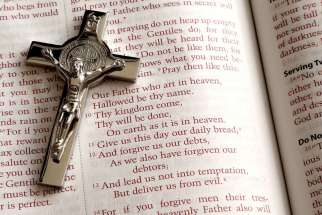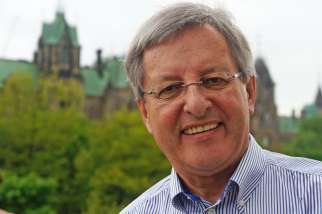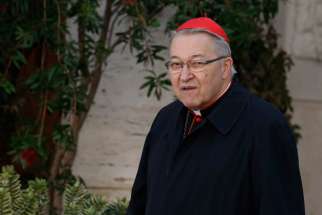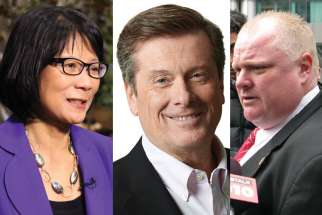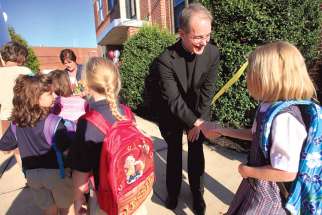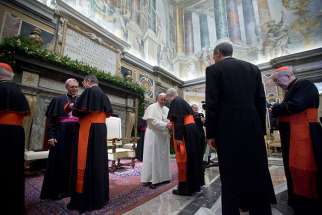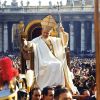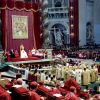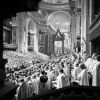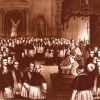Equal platform
The institutions of society should always show respect and tolerance for people of every faith or no faith. The goal should be inclusiveness and accommodation. That’s how a genuinely pluralistic, multicultural society works.
OTTAWA - The Supreme Court of Canada ruled April 15 that Saguenay council must stop praying before meetings and pay damages to an atheist who launched a complaint in the matter.
GENEVA - No one is exempt from either the impacts of climate change or the moral responsibility to act to address this global concern, a Vatican official told members of the U.N. Human Rights Council.
Synod on the family's dynamics recalls the Second Vatican Council
VATICAN CITY - Even before the start of the Oct. 5-19 Synod of Bishops on the family, observers were likening it to the Second Vatican Council of 1962-65.
Interfaith council hosts mayoral debate
TORONTO - If you’ve been waiting for your chance to hear Toronto’s mayoral candidates address poverty, housing, faith and ethics all at the same time — and maybe even use the word “praxis” — the Toronto Area Interfaith Council has the all-candidates event for you.
Get to know your local Catholic school
The start of the school year is a time of excitement and anticipation for students, and a time of some anxiety for parents as they see their children off to a new school, a new grade or a new program. These feelings apply regardless of whether the students attend elementary or secondary school, or even if they’re off to college or university.
VATICAN CITY - The Roman Curia did not have any "pontifical councils" until 1967, but since then they have become a popular structure for focusing attention on practical areas of life in the church and the world.
‘Reform’ the unspoken word at Vatican II
WASHINGTON - The Second Vatican Council was “animated by a spirit of reform,” but was afraid to use the word “reform,” Church historian Jesuit Father John O’Malley told a conference marking the 50th anniversary of the opening of the council.
In its 16 documents, Vatican II used the Latin word for reform, “reformatio,” only once — in its Decree on Ecumenism when it said the Church is in need of continual reform, said O’Malley, a professor in the theology department at Georgetown University. Other than that, it preferred “softer words,” such as renewal, updating or even modernizing, he said.
O’Malley was a keynote speaker Sept. 27 at the symposium “Reform and Renewal: Vatican II After Fifty Years” held at The Catholic University of America.
The Jesuit noted that Fr. Yves Congar, a French Dominican theologian and expert on ecumenism, wrote his book True and False Reform in the Church in the 1950s that “a veritable curse” seemed to hang over the word “reform.” And when Cardinal Angelo Roncalli, the future Pope John XXIII, heard of Congar’s book, he said, “Reform of the Church; is such a thing possible?”
The Vatican’s Holy Office forbade the reprinting of Congar’s book or its translation into other languages from the original French, he said. But during Vatican II, the priest was one of many theologians helping the bishops; Pope John Paul II made him a cardinal in 1994.
O’Malley traced the history of reform in early Church councils up to and including the 16th-century Council of Trent. Trent, however, coming on the heels of the Protestant Reformation, repeatedly insisted on the Church’s unbroken continuity with the faith and practice of the apostolic Church.
“In its insistence on continuity, Trent helped develop the tradition and fostered the Catholic mindset reluctant to admit change in the course of the Church’s history and teaching,” O’Malley told an audience of about 250 people.
“By the early 17th century, Catholic reluctance to see or admit change had become deeply rooted and pervasive.”
As well, Protestants had laid claim to the word “reform” as their own, he said. The word then “suffered banishment as foreign to Catholicism and subversive of it.”
That all changed in 2005 when, shortly after his election, Pope Benedict XVI gave a speech to the Roman Curia describing Vatican II as a council of reform, rather than one of rupture with the Catholic tradition, he said.
“Reform is, according to him, a process that within continuity produces something new,” O’Malley said. “The council, while faithful to the tradition, did not receive it as inert but as somehow dynamic.”
The Church, according to Pope Benedict, grows and develops in time, but nonetheless remains always the same, he said.
In another talk, Chad Pecknold, an assistant professor of historical and systematic theology at Catholic University, traced Pope Benedict’s aversion to theories of ruptures in Church history to his research into St. Bonaventure’s theology as the young Joseph Ratzinger.
St. Bonaventure was critical of the theory of the 12th-century monk Joachim of Fiore, who maintained that there are three eras in salvation history — the Old Testament age of the Father, the clergy-dominated era of the Son and the age of the Spirit in which spiritual men would hold first place and there would no longer be sacraments or a hierarchy.
Joachim predicted the age of the Spirit would begin in 1260, Pecknold said.
For St. Bonaventure and St. Thomas Aquinas, there could only be one rupture, humanity’s redemption in Jesus Christ, he said.
Moreover, not only was Joachim wrong about history, he also was wrong about God. His theory implied that the Father, Son and Spirit are three gods acting independently.
Pope Benedict, said Pecknold, sees any interpretation of Vatican II that separates the spirit of the council from its actual teaching is to see it in the same light as Joachim’s view of history. To interpret Vatican II as a rupture with the past is, for the Pope, an interpretation which is “bound to be church-dividing and is thus non-Catholic,” he said.
(Western Catholic Reporter)
What changed at Vatican II
Things changed with the Second Vatican Council. No one disputes that the Catholic faith remained what it has always been. The Church still teaches what the Church always taught. But the Council did not assemble 2,860 bishops to recite the catechism. The fact that the bishops commissioned the first authoritative catechism in 350 years was just one of many changes initiated at the Council.
Among the most important changes:
- Liturgy: Vernacular languages were encouraged, especially for Scripture readings at Mass, which became far more extensive with added Old Testament readings and a cycle of three years which focusses on each of the three synoptic Gospels (Matthew, Luke and Mark). By 1969 the Novus Ordo Mass allowed priests for pastoral reasons to face the assembly, gave the celebrant a variety of eucharistic prayers, restored the sign of peace to the entire congregation, allowed for distribution of both the body and blood of Christ under the forms of bread and wine and moved tabernacles off the altars to a noble and prominent location elsewhere in the church or a separate chapel. By 1973 the International Commission for English in the Liturgy produced the first official translation of the New Mass, though various provisional translations had been circulating since the end of the Council.
- Ecumenism: Unitatis Redintegratio declared the ecumenical movement a good thing, encouraged Catholics to be part of it and referred to Eastern, Oriental and Protestant Christians as "separated brethren." In 1928 Pope Pius XI had condemned the ecumenical movement. From the Council of Trent until the Second Vatican Council Protestants were officially referred to as heretics.
- Democracy and religious liberty: In Dignitatis Humanae the Church for the first time recognized the conscience rights of all people to freedom of religion, and declared it was the responsibility of states to protect religious freedom with stable laws. The idea that the state should be neutral in religion, or that liberal democratic states could be entrusted to protect human dignity or even that there was any such thing as a right to religious freedom, had been condemned by Pope Pius IX.
- Relations with Jews: "The Jews should not be presented as rejected or accursed by God," said Nostra Aetate. The charge of deicide was unfounded. The New Covenant is not possible without Abraham's stock.
- Relations with other religions: "The Church rejects nothing that is true and holy in these religions," said Nostra Aetate.
- Religious Life: Sisters, brothers and religious order priests were to do two things — rediscover the original purpose of their religious order and adapt it to the modern world, said Perfectae Caritatis.
- Canon Law: The Council fathers ordered a revised and written code of canon law that was finally delivered under Pope John Paul II in 1983.The movers and shakers behind the Second Vatican Council
The Second Vatican Council was the biggest stage in the history of the Church. There were more bishops present than at any the 20 previous councils stretching from the First Council of Nicaea in 325 to the First Vatican Council of 1870. And the bishops present came from more countries, more cultures, more languages than the Church had ever experienced.
Councils date back to early days
The model for all ecumenical councils is the Council of Jerusalem, recalled in the Acts of the Apostles, chapter 15. However, it is not generally listed as one of the 20 ecumenical councils of Church history. Ecumenical (from the Greek word oikoumene) means worldwide, and the first one was called by the Emperor of the known world, Constantine I.
1. First Council of Nicea in 325 defined the heresy of Arianism.
2. First Council of Constantinople in 381 again repudiated Arianism.
3. Council of Ephesus in 431 declared Mary as "God carrier" or Theotokos.
4. Council of Chalcedon in 451 made more explicit that Jesus' divine and human natures were united in a single being.
5. Second Council of Constantinople in 553 condemned Origen of Alexandria, the first great Scripture scholar of Christianity, for some odd ideas he had about the transmigration of souls.
6. Third Council of Constantinople in 680-681 dealt with more threats to unity of Christ, specifically a theory that Jesus had two wills — one divine and one human — but one nature. Monothelitism was condemned as heresy.
7. Second Council of Nicea in 787 tried to stop people from going around smashing icons. Veneration of icons was defined as good and iconoclasm was condemned.
8. Fourth Council of Constantinople in 869-870 restored St. Ignatius to his throne as Patriarch of Constantinople.
9. First Lateran Council in 1123 excommunicated the Holy Roman Emporer Henry V and declared it heresy for kings, princes and even the Holy Roman Emporer to appoint bishops. This was known as the investure controversy and it went on for centuries. The council also tried to impose celibacy on secular priests.
10. Second Lateran Council in 1139 was another attempt to get kings out of the business of the Church, and also tried to reform the clergy, including another condemnation of marriage among priests.
11. Third Lateran Council in 1179 condemned the sale of sacraments and positions in the hierarchy (simony) and declared only cardinals could elect the pope.
12. Fourth Lateran Council in 1215 defined transubstantiation, a term that remained controversial at the Second Vatican Council.
13. First Council of Lyon in 1245 excommunicated and deposed Holy Roman Emperor Frederick II who had put Rome under siege. Pope Innocent IV also used the Council to strike an alliance with King Louis IX of France and launch the Seventh Crusade under the French king's command.
14. Second Council of Lyon in 1274 under Blessed Pope Gregory X tried to repair the Great Schism of 1054. However, Greek Orthodox bishops were condemned for attending the Council when they returned home.
15. Council of Vienna in 1311 to 1312 marked the end of the crusades. The Knights Templar lost their Church support and Franciscan Ramon Llull (Raymond Lully) convinced the Council fathers the only way to retake the Holy Land was to learn the languages — specifically Hebrew, Arabic and Greek.
16. Council of Constance in 1414 to 1418 had to solve the problem of three popes: Anti-pope John XXIII, Avignon Pope Benedict XIII and Pope Gregory XII had all been elected by some bishops in a situation known as the Western Schism of 1378 to 1417. The Council of Constance resolved the schism by declaring an ecumenical council is a higher authority even than the pope who convokes it and then installing Pope Martin V.
17. Council of Florence opened in 1431 in Basel with no bishops, moved to Ferrara, Florence and finally Lousanne. There were wars in Bohemia, a rising threat in the Ottoman Empire and plague. The council tried to assert the idea of conciliarity, that councils should be part of the normal governance of the Church, and it achieved a short-lived reconciliation with some Greek Orthodox bishops and the Armenian Church.
18. The Fifth Lateran Council, the last before the Reformation, from 1512 to 1517 amounted to a battle royal between the forces of conciliarism and Pope Julius II's convictions about papal authority. Master of the Dominican order Thomas Cajetan argued for absolute papal authority against University of Paris theologian Jacques Almain. The Council passed a decree backing Cajetan's position.
19. Council of Trent from 1559 to 1565 tried to answer the challenge of Martin Luther, but came along too late to reunite a divided Western Church. The council's doctrine of salvation, definitions of the sacraments and reforms to the liturgy defined Catholicism for 350 years. It initiated the Catechism of 1568, a new Roman Missal which defined the Tridentine Mass, issued a new edition of the Vulgate — the Bible in Latin — and pronounced a long series of anathemas. It also envisioned the seminary system in the hope of a better educated clergy and encouraged the Mass in local languages, a reform that had to wait for the Second Vatican Council.
20. First Vatican Council of 1869 to 1870 defined papal infallibility. Papal infalibility was then used in 1950 by Pope Pius XII to declare the Assumption of the Blessed Virgin Mary into Heaven a universally accepted dogma of the Church.
21. Second Vatican Council of 1962 to 1965 was convoked after the Second World War and during the Cold War by Blessed Pope John XXIII.


